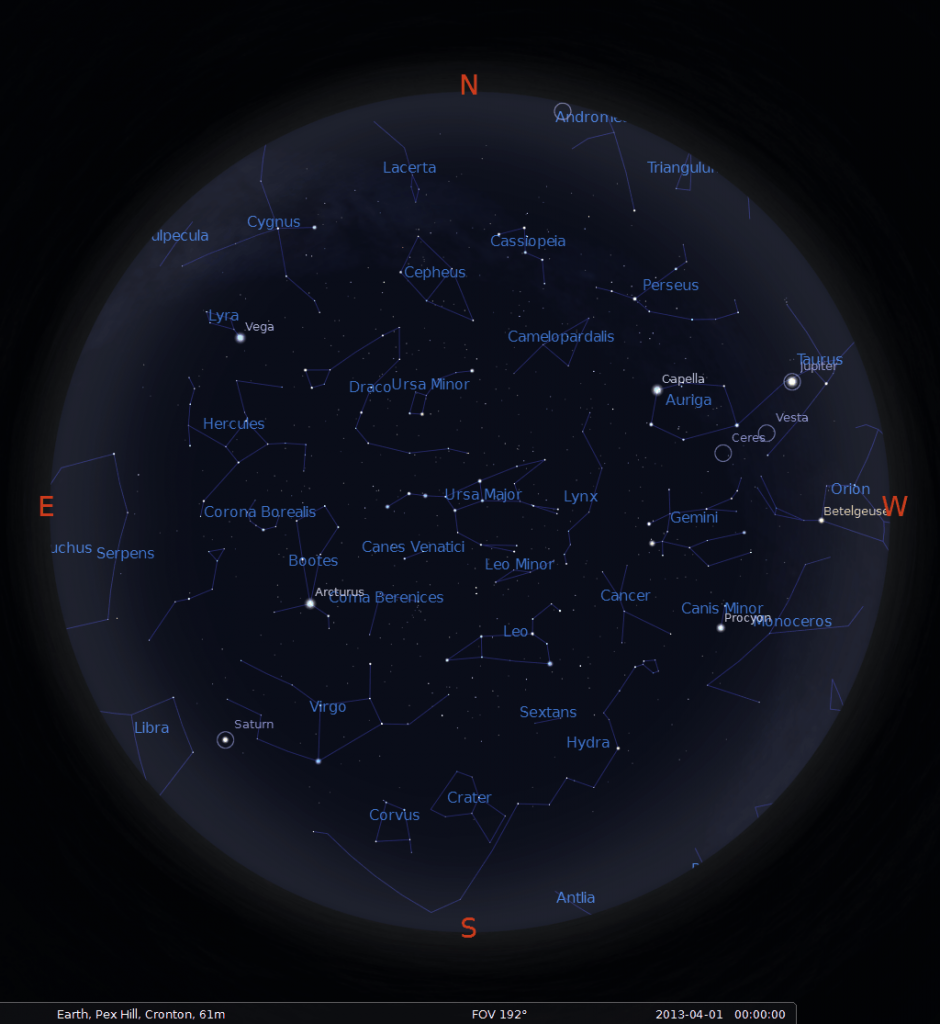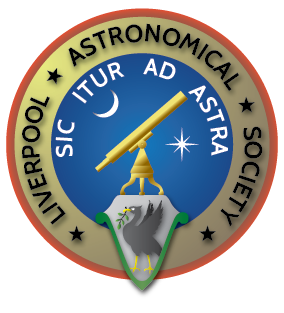British Summer Time came into effect on 31st March 2013 – times below have been adjusted and are in BST!

(Click to enlarge)
What’s visible in the sky above Liverpool in April 2013?
Map is valid for:
1st April 2013 at 00:00 BST
15th April 2013 at 23:00 BST
30th April 2013 at 22:00 BST
The Sun
| 1st April 2013 | 6th April 2013 | 11th April 2013 | 16th April 2013 | 21st April 2013 | 26th April 2013 | 1st May 2013 | |
|---|---|---|---|---|---|---|---|
| Sunrise | 06:45 BST | 06:33 BST | 06:22 BST | 06:10 BST | 05:59 BST | 05:48 BST | 05:37 BST |
| Sunset | 19:47 BST | 19:57 BST | 20:06 BST | 20:15 BST | 20:24 BST | 20:33 BST | 20:42 BST |
The Moon
 |
 |
 |
 |
 |
|
|---|---|---|---|---|---|
| Last Quarter | New Moon | First Quarter | Full Moon | Last Quarter | |
| Date | 3rd April 2013 | 10th April 2013 | 18th April 2013 | 25th April 2013 | 2nd May 2013 |
| Time | 05:37 BST | 10:36 BST | 13:32 BST | 20:58 BST | 12:15 BST |
A partial eclipse of the Moon will take place on 25th April 2013, however only a sliver of the Moon’s Northern edge will enter the Umbral Shadow of the Earth, with the rest of the satellite in the Penumbra. This eclipse is not expected to be of note, other than that it is the 2nd shortest partial eclipse of the Moon of the 21st Century.
| Eclipse Phase & Stage | Date | Time | Notes |
|---|---|---|---|
| Penumbral phase begins | 25th April 2013 | 19:01 BST | This stage is not visible as the Moon is below the horizon |
| Umbral phase begins | 20:51 BST | ||
| Maximum eclipse | 21:07 BST | ||
| Umbral phase ends | 21:23 BST | ||
| Penumbral phase ends | 23:13 BST |
Planets
Mercury
Mercury is poorly placed for the Northern Hemisphere during April.
Venus
Venus cannot be observed this month as it has only just passed Superior Conjunction.
Mars
Mars is another planet which cannot be seen this month due to its line-of-sight proximity with the Sun, as it reaches Solar Conjunction on May 18th 2013.
Jupiter
Jupiter is still visible in the constellation of Taurus (the bull), which is setting earlier now as the summer constellations come into play.
The Moon will pass less than 3° to the South of Jupiter on the night of the 14th April at about 21:00 BST.
Saturn
Saturn reaches Opposition on the 28th April 2013 and can be found in the constellation of Virgo (the virgin), and the planet is still tilted well enough to show the open ring system clearly.
Comets
Comet C/2011 L4 (Pan-STARRS) is fading after its close approach to the Sun, however it is visible in binoculars even in somewhat light-polluted skies.
On 1st April at 22:00 BST the comet can be found just below the Andromeda Galaxy.
The comet is moving quite fast, having been flung by the Sun’s gravity and by mid-April it will be found to the lower-right of the “W” of Cassiopeia, however it may be more difficult to spot due to its increasing distance from the Sun and us, although its higher elevation in the sky may counteract this somewhat.
On the night of 20th April 2013, at about 02:40 BST, Comet Pan-STARRS will pass between the rightmost two stars of the “W” of Cassiopeia, Schedar (α-Cassiopeiae) and Caph (β-Cassiopeiae).
Meteors
| Name of Shower | Date of Peak | Favourability | Notes |
|---|---|---|---|
| Virginid | 12th April 2013 | Favourable | New Moon occurs on 10th April 2013 Radiant is near Libra |
| alpha-Virginid | |||
| April Lyrids | 22nd-23rd April 2013 | Unfavourable | Full Moon occurs on 25th April 2013 |
| alpha-Scorpiid | 28th April 2013 | Unfavourable | This is a sparse shower |


